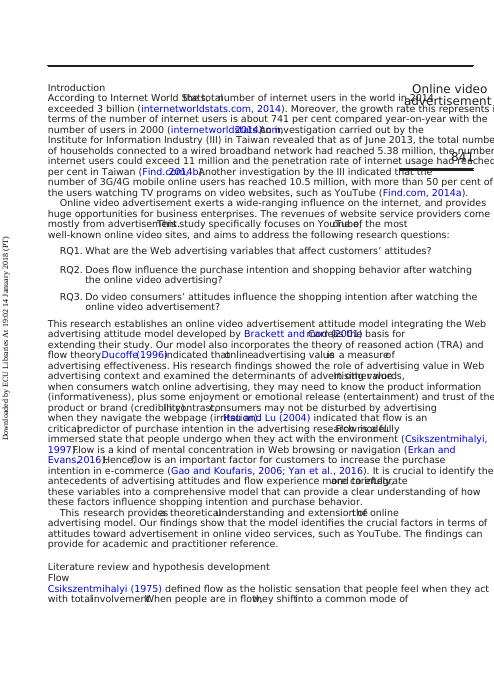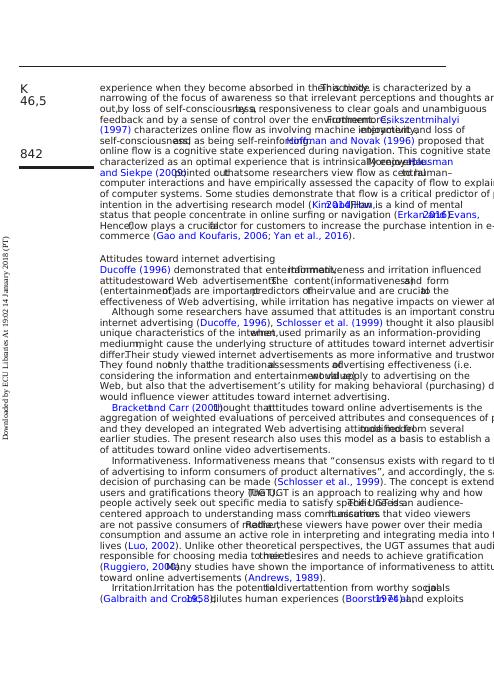Ask a question from expert
Consumer Attitudes Toward Online Video Advertisement
16 Pages8133 Words156 Views
Added on 2021-07-20
Consumer Attitudes Toward Online Video Advertisement
Added on 2021-07-20
BookmarkShareRelated Documents
*Related content and download information correct at time of download.
Downloaded by ECU Libraries At 19:02 14 January 2018 (PT)
Downloaded by ECU Libraries At 19:02 14 January 2018 (PT)

Consumer attitudes towardonline video advertisement:YouTube as a platformKeng-Chieh YangDepartment of Information Management, Hwa Hsia University of Technology,
New Taipei City, Taiwan
Chia-Hui HuangDepartment of Business Administration, National Taipei University of Business,
Taipei, Taiwan
Conna YangCenter for General Education, Ming Chuan University, Taipei, Taiwan, and
Su Yu YangDepartment of Information Management, National Chiao Tung University,
Hsinchu, Taiwan
Abstract
Purpose –Online video advertisement is a wide-ranging phenomenon on the internet that provides huge
opportunities for business enterprises.The revenues ofwebsite service providers come primarily from
advertisement.However,it is rare to find research focusing on consumer attitudes toward online video
advertisement.This study aims to investigate consumer attitudes toward advertisementwhile they are
watching online videos on YouTube.
Design/methodology/approach –The paper followed Brackett and Carr’s (2001)Web Advertising
Attitudes Model and combined it with the theory of reasoned action (TRA) and the flow theory.This study
investigates consideration ofthe factors affecting attitudes toward advertisementand the influence on
shopping intention and purchase behavior.
Findings – The findings indicate that entertainment,informativeness,irritation and credibility have a
shopping influence on purchase attitudes.Flow,on the other hand,does have an influence on shopping
intention and purchase behavior. The discussion and conclusion have been further discussed.
Originality/value –This study provides a comprehensive modelfor online video advertisement.This
model was based on Brackett and Carr’s model, combining the users and gratifications theory, TRA and flow
theory to develop an online video advertisement model. Researchers can consider this model as a framework
and use it to capture a more complete picture of the relevant phenomena in their works.
Keywords YouTube, Consumer attitudes, Theory of reasoned action, Flow theory,
Online video advertisement
Paper type Research paper
The previous draft has been published in IEEE International Conference on Industrial Engineering
and Engineering Management (IEEM2014). The authors modified and extended the content based on
somescholars’suggestionsto develop thiswork.The authorswould liketo appreciatethe
anonymous referees for their useful comments and suggestions which helped to improve the quality
and presentation of this manuscript. Also, special thanks to the Ministry of Science and Technology,
Taiwan,for financially supporting this research under Grant No.NSC 102-2815-C-146-003-H,MOST
104-2410-H-146-001 and MOST 104-2410-H-141-016.
K
46,5
840
Kybernetes
Vol. 46 No. 5, 2017
pp.840-853
© Emerald Publishing Limited
0368-492X
DOI 10.1108/K-03-2016-0038
The current issue and full text archive of this journal is available on Emerald Insight at:
www.emeraldinsight.com/0368-492X.htm
Downloaded by ECU Libraries At 19:02 14 January 2018 (PT)
New Taipei City, Taiwan
Chia-Hui HuangDepartment of Business Administration, National Taipei University of Business,
Taipei, Taiwan
Conna YangCenter for General Education, Ming Chuan University, Taipei, Taiwan, and
Su Yu YangDepartment of Information Management, National Chiao Tung University,
Hsinchu, Taiwan
Abstract
Purpose –Online video advertisement is a wide-ranging phenomenon on the internet that provides huge
opportunities for business enterprises.The revenues ofwebsite service providers come primarily from
advertisement.However,it is rare to find research focusing on consumer attitudes toward online video
advertisement.This study aims to investigate consumer attitudes toward advertisementwhile they are
watching online videos on YouTube.
Design/methodology/approach –The paper followed Brackett and Carr’s (2001)Web Advertising
Attitudes Model and combined it with the theory of reasoned action (TRA) and the flow theory.This study
investigates consideration ofthe factors affecting attitudes toward advertisementand the influence on
shopping intention and purchase behavior.
Findings – The findings indicate that entertainment,informativeness,irritation and credibility have a
shopping influence on purchase attitudes.Flow,on the other hand,does have an influence on shopping
intention and purchase behavior. The discussion and conclusion have been further discussed.
Originality/value –This study provides a comprehensive modelfor online video advertisement.This
model was based on Brackett and Carr’s model, combining the users and gratifications theory, TRA and flow
theory to develop an online video advertisement model. Researchers can consider this model as a framework
and use it to capture a more complete picture of the relevant phenomena in their works.
Keywords YouTube, Consumer attitudes, Theory of reasoned action, Flow theory,
Online video advertisement
Paper type Research paper
The previous draft has been published in IEEE International Conference on Industrial Engineering
and Engineering Management (IEEM2014). The authors modified and extended the content based on
somescholars’suggestionsto develop thiswork.The authorswould liketo appreciatethe
anonymous referees for their useful comments and suggestions which helped to improve the quality
and presentation of this manuscript. Also, special thanks to the Ministry of Science and Technology,
Taiwan,for financially supporting this research under Grant No.NSC 102-2815-C-146-003-H,MOST
104-2410-H-146-001 and MOST 104-2410-H-141-016.
K
46,5
840
Kybernetes
Vol. 46 No. 5, 2017
pp.840-853
© Emerald Publishing Limited
0368-492X
DOI 10.1108/K-03-2016-0038
The current issue and full text archive of this journal is available on Emerald Insight at:
www.emeraldinsight.com/0368-492X.htm
Downloaded by ECU Libraries At 19:02 14 January 2018 (PT)

Introduction
According to Internet World Stats,the totalnumber of internet users in the world in 2014
exceeded 3 billion (internetworldstats.com, 2014). Moreover, the growth rate this represents in
terms of the number of internet users is about 741 per cent compared year-on-year with the
number of users in 2000 (internetworldstats.com,2014).An investigation carried out by the
Institute for Information Industry (III) in Taiwan revealed that as of June 2013, the total number
of households connected to a wired broadband network had reached 5.38 million, the number of
internet users could exceed 11 million and the penetration rate of internet usage had reached 48
per cent in Taiwan (Find.com,2014b).Another investigation by the III indicated that the
number of 3G/4G mobile online users has reached 10.5 million, with more than 50 per cent of
the users watching TV programs on video websites, such as YouTube (Find.com, 2014a).
Online video advertisement exerts a wide-ranging influence on the internet, and provides
huge opportunities for business enterprises. The revenues of website service providers come
mostly from advertisement.This study specifically focuses on YouTube,one of the most
well-known online video sites, and aims to address the following research questions:
RQ1. What are the Web advertising variables that affect customers’ attitudes?
RQ2. Does flow influence the purchase intention and shopping behavior after watching
the online video advertising?
RQ3. Do video consumers’ attitudes influence the shopping intention after watching the
online video advertisement?
This research establishes an online video advertisement attitude model integrating the Web
advertising attitude model developed by Brackett and Carr (2001)modelas the basis for
extending their study. Our model also incorporates the theory of reasoned action (TRA) and
flow theory.Ducoffe(1996)indicated thatonlineadvertising valueis a measureof
advertising effectiveness. His research findings showed the role of advertising value in Web
advertising context and examined the determinants of advertising value.In other words,
when consumers watch online advertising, they may need to know the product information
(informativeness), plus some enjoyment or emotional release (entertainment) and trust of the
product or brand (credibility).In contrast,consumers may not be disturbed by advertising
when they navigate the webpage (irritation).Hsu and Lu (2004) indicated that flow is an
criticalpredictor of purchase intention in the advertising research model.Flow is a fully
immersed state that people undergo when they act with the environment (Csikszentmihalyi,
1997).Flow is a kind of mental concentration in Web browsing or navigation (Erkan and
Evans,2016).Hence,flow is an important factor for customers to increase the purchase
intention in e-commerce (Gao and Koufaris, 2006; Yan et al., 2016). It is crucial to identify the
antecedents of advertising attitudes and flow experience more carefully,and to integrate
these variables into a comprehensive model that can provide a clear understanding of how
these factors influence shopping intention and purchase behavior.
This research providesa theoreticalunderstanding and extension ofthe online
advertising model. Our findings show that the model identifies the crucial factors in terms of
attitudes toward advertisement in online video services, such as YouTube. The findings can
provide for academic and practitioner reference.
Literature review and hypothesis development
Flow
Csikszentmihalyi (1975) defined flow as the holistic sensation that people feel when they act
with totalinvolvement.When people are in flow,they shiftinto a common mode of
Online video
advertisement
841
Downloaded by ECU Libraries At 19:02 14 January 2018 (PT)
According to Internet World Stats,the totalnumber of internet users in the world in 2014
exceeded 3 billion (internetworldstats.com, 2014). Moreover, the growth rate this represents in
terms of the number of internet users is about 741 per cent compared year-on-year with the
number of users in 2000 (internetworldstats.com,2014).An investigation carried out by the
Institute for Information Industry (III) in Taiwan revealed that as of June 2013, the total number
of households connected to a wired broadband network had reached 5.38 million, the number of
internet users could exceed 11 million and the penetration rate of internet usage had reached 48
per cent in Taiwan (Find.com,2014b).Another investigation by the III indicated that the
number of 3G/4G mobile online users has reached 10.5 million, with more than 50 per cent of
the users watching TV programs on video websites, such as YouTube (Find.com, 2014a).
Online video advertisement exerts a wide-ranging influence on the internet, and provides
huge opportunities for business enterprises. The revenues of website service providers come
mostly from advertisement.This study specifically focuses on YouTube,one of the most
well-known online video sites, and aims to address the following research questions:
RQ1. What are the Web advertising variables that affect customers’ attitudes?
RQ2. Does flow influence the purchase intention and shopping behavior after watching
the online video advertising?
RQ3. Do video consumers’ attitudes influence the shopping intention after watching the
online video advertisement?
This research establishes an online video advertisement attitude model integrating the Web
advertising attitude model developed by Brackett and Carr (2001)modelas the basis for
extending their study. Our model also incorporates the theory of reasoned action (TRA) and
flow theory.Ducoffe(1996)indicated thatonlineadvertising valueis a measureof
advertising effectiveness. His research findings showed the role of advertising value in Web
advertising context and examined the determinants of advertising value.In other words,
when consumers watch online advertising, they may need to know the product information
(informativeness), plus some enjoyment or emotional release (entertainment) and trust of the
product or brand (credibility).In contrast,consumers may not be disturbed by advertising
when they navigate the webpage (irritation).Hsu and Lu (2004) indicated that flow is an
criticalpredictor of purchase intention in the advertising research model.Flow is a fully
immersed state that people undergo when they act with the environment (Csikszentmihalyi,
1997).Flow is a kind of mental concentration in Web browsing or navigation (Erkan and
Evans,2016).Hence,flow is an important factor for customers to increase the purchase
intention in e-commerce (Gao and Koufaris, 2006; Yan et al., 2016). It is crucial to identify the
antecedents of advertising attitudes and flow experience more carefully,and to integrate
these variables into a comprehensive model that can provide a clear understanding of how
these factors influence shopping intention and purchase behavior.
This research providesa theoreticalunderstanding and extension ofthe online
advertising model. Our findings show that the model identifies the crucial factors in terms of
attitudes toward advertisement in online video services, such as YouTube. The findings can
provide for academic and practitioner reference.
Literature review and hypothesis development
Flow
Csikszentmihalyi (1975) defined flow as the holistic sensation that people feel when they act
with totalinvolvement.When people are in flow,they shiftinto a common mode of
Online video
advertisement
841
Downloaded by ECU Libraries At 19:02 14 January 2018 (PT)

experience when they become absorbed in their activity.This mode is characterized by a
narrowing of the focus of awareness so that irrelevant perceptions and thoughts are filtered
out,by loss of self-consciousness,by a responsiveness to clear goals and unambiguous
feedback and by a sense of control over the environment.Furthermore,Csikszentmihalyi
(1997) characterizes online flow as involving machine interactivity,enjoyment and loss of
self-consciousness,and as being self-reinforcing.Hoffman and Novak (1996) proposed that
online flow is a cognitive state experienced during navigation. This cognitive state has been
characterized as an optimal experience that is intrinsically enjoyable.Moreover,Hausman
and Siekpe (2009)pointed outthatsome researchers view flow as centralto human–
computer interactions and have empirically assessed the capacity of flow to explain the use
of computer systems. Some studies demonstrate that flow is a critical predictor of purchase
intention in the advertising research model (Kim and Han,2014).Flow is a kind of mental
status that people concentrate in online surfing or navigation (Erkan and Evans,2016).
Hence,flow plays a crucialfactor for customers to increase the purchase intention in e-
commerce (Gao and Koufaris, 2006; Yan et al., 2016).
Attitudes toward internet advertising
Ducoffe (1996) demonstrated that entertainment,informativeness and irritation influenced
attitudestoward Web advertisements.The content(informativeness)and form
(entertainment)of ads are importantpredictors oftheirvalue and are crucialto the
effectiveness of Web advertising, while irritation has negative impacts on viewer attitudes.
Although some researchers have assumed that attitudes is an important construct of
internet advertising (Ducoffe, 1996), Schlosser et al. (1999) thought it also plausible that the
unique characteristics of the internet,when used primarily as an information-providing
medium,might cause the underlying structure of attitudes toward internet advertising to
differ.Their study viewed internet advertisements as more informative and trustworthy.
They found notonly thatthe traditionalassessments ofadvertising effectiveness (i.e.
considering the information and entertainment value)would apply to advertising on the
Web, but also that the advertisement’s utility for making behavioral (purchasing) decisions
would influence viewer attitudes toward internet advertising.
Brackettand Carr (2001)thought thatattitudes toward online advertisements is the
aggregation of weighted evaluations of perceived attributes and consequences of products,
and they developed an integrated Web advertising attitude modelmodified from several
earlier studies. The present research also uses this model as a basis to establish a new model
of attitudes toward online video advertisements.
Informativeness. Informativeness means that “consensus exists with regard to the ability
of advertising to inform consumers of product alternatives”, and accordingly, the satisfying
decision of purchasing can be made (Schlosser et al., 1999). The concept is extended from the
users and gratifications theory (UGT).The UGT is an approach to realizing why and how
people actively seek out specific media to satisfy specific needs.The UGT is an audience-
centered approach to understanding mass communication.It assumes that video viewers
are not passive consumers of media.Rather,these viewers have power over their media
consumption and assume an active role in interpreting and integrating media into their own
lives (Luo, 2002). Unlike other theoretical perspectives, the UGT assumes that audiences are
responsible for choosing media to meettheir desires and needs to achieve gratification
(Ruggiero, 2000).Many studies have shown the importance of informativeness to attitudes
toward online advertisements (Andrews, 1989).
Irritation.Irritation has the potentialto divertattention from worthy socialgoals
(Galbraith and Crook,1958),dilutes human experiences (Boorstin et al.,1974) and exploits
K
46,5
842
Downloaded by ECU Libraries At 19:02 14 January 2018 (PT)
narrowing of the focus of awareness so that irrelevant perceptions and thoughts are filtered
out,by loss of self-consciousness,by a responsiveness to clear goals and unambiguous
feedback and by a sense of control over the environment.Furthermore,Csikszentmihalyi
(1997) characterizes online flow as involving machine interactivity,enjoyment and loss of
self-consciousness,and as being self-reinforcing.Hoffman and Novak (1996) proposed that
online flow is a cognitive state experienced during navigation. This cognitive state has been
characterized as an optimal experience that is intrinsically enjoyable.Moreover,Hausman
and Siekpe (2009)pointed outthatsome researchers view flow as centralto human–
computer interactions and have empirically assessed the capacity of flow to explain the use
of computer systems. Some studies demonstrate that flow is a critical predictor of purchase
intention in the advertising research model (Kim and Han,2014).Flow is a kind of mental
status that people concentrate in online surfing or navigation (Erkan and Evans,2016).
Hence,flow plays a crucialfactor for customers to increase the purchase intention in e-
commerce (Gao and Koufaris, 2006; Yan et al., 2016).
Attitudes toward internet advertising
Ducoffe (1996) demonstrated that entertainment,informativeness and irritation influenced
attitudestoward Web advertisements.The content(informativeness)and form
(entertainment)of ads are importantpredictors oftheirvalue and are crucialto the
effectiveness of Web advertising, while irritation has negative impacts on viewer attitudes.
Although some researchers have assumed that attitudes is an important construct of
internet advertising (Ducoffe, 1996), Schlosser et al. (1999) thought it also plausible that the
unique characteristics of the internet,when used primarily as an information-providing
medium,might cause the underlying structure of attitudes toward internet advertising to
differ.Their study viewed internet advertisements as more informative and trustworthy.
They found notonly thatthe traditionalassessments ofadvertising effectiveness (i.e.
considering the information and entertainment value)would apply to advertising on the
Web, but also that the advertisement’s utility for making behavioral (purchasing) decisions
would influence viewer attitudes toward internet advertising.
Brackettand Carr (2001)thought thatattitudes toward online advertisements is the
aggregation of weighted evaluations of perceived attributes and consequences of products,
and they developed an integrated Web advertising attitude modelmodified from several
earlier studies. The present research also uses this model as a basis to establish a new model
of attitudes toward online video advertisements.
Informativeness. Informativeness means that “consensus exists with regard to the ability
of advertising to inform consumers of product alternatives”, and accordingly, the satisfying
decision of purchasing can be made (Schlosser et al., 1999). The concept is extended from the
users and gratifications theory (UGT).The UGT is an approach to realizing why and how
people actively seek out specific media to satisfy specific needs.The UGT is an audience-
centered approach to understanding mass communication.It assumes that video viewers
are not passive consumers of media.Rather,these viewers have power over their media
consumption and assume an active role in interpreting and integrating media into their own
lives (Luo, 2002). Unlike other theoretical perspectives, the UGT assumes that audiences are
responsible for choosing media to meettheir desires and needs to achieve gratification
(Ruggiero, 2000).Many studies have shown the importance of informativeness to attitudes
toward online advertisements (Andrews, 1989).
Irritation.Irritation has the potentialto divertattention from worthy socialgoals
(Galbraith and Crook,1958),dilutes human experiences (Boorstin et al.,1974) and exploits
K
46,5
842
Downloaded by ECU Libraries At 19:02 14 January 2018 (PT)

End of preview
Want to access all the pages? Upload your documents or become a member.